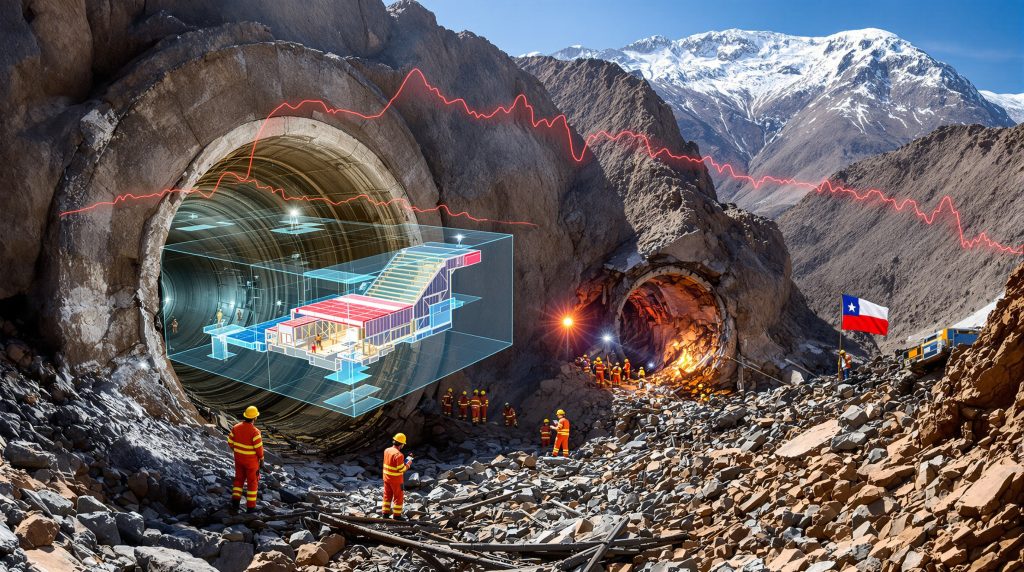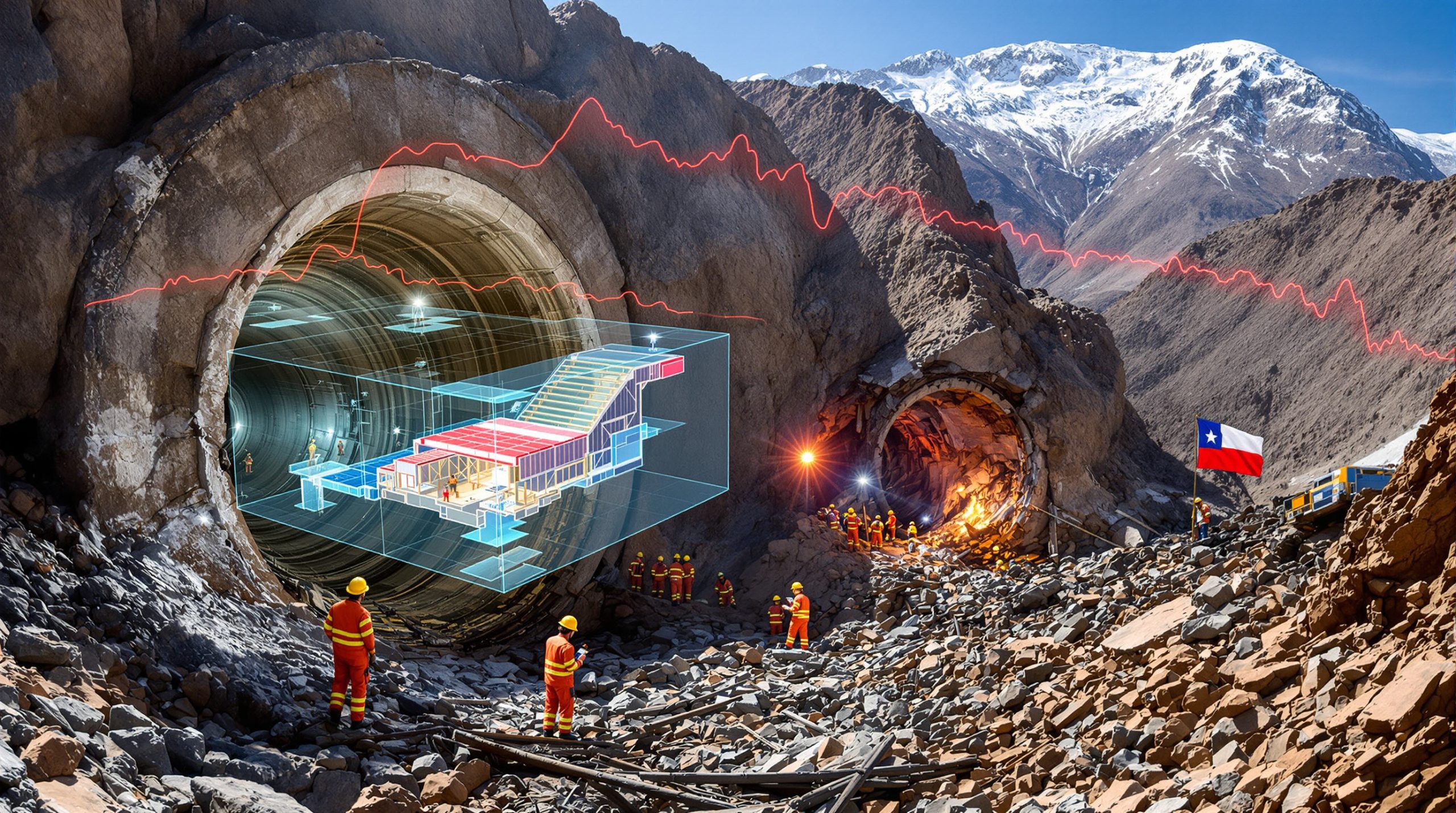Understanding the El Teniente Mine Collapse: Investigation Timeline and Safety Implications
The El Teniente copper mine in Chile experienced a catastrophic collapse in July 2025, resulting in the deaths of six workers. This incident, which occurred in the Andesita sector of the mine, has triggered multiple investigations by Chilean authorities, including the National Geology and Mining Service (Sernageomin). According to Andres León, Sernageomin's director, the investigation into fatal mine collapse in Chile is expected to take several months due to the complex nature of the accident.
This tragic event represents the deadliest mining accident in Chile in recent years, raising important questions about mining safety protocols and regulatory oversight in one of the world's leading copper-producing nations.
Why Is the Investigation Taking So Long?
Underground mine collapses present unique investigative challenges that typically extend the timeline for comprehensive analysis. In the case of El Teniente, investigators face multiple complex aspects requiring detailed examination.
Complexity of Underground Mine Collapses
Underground mining investigations require significantly more time and resources than surface operations for several reasons:
- Difficult access to collapsed areas requiring specialized equipment and safety protocols
- Need for comprehensive structural engineering analysis of failed supports
- Detailed geological assessment of rock mechanics and potential seismic influences
- Forensic reconstruction of pre-collapse conditions
- Examination of maintenance records spanning months or years before the incident
- Analysis of ground movement monitoring data from multiple sensor systems
The physical complexity of the El Teniente mine itself compounds these challenges. As the world's largest underground mining engineering operation with over 3,000 kilometers of tunnels and a century of mining history, investigators must navigate a labyrinth of interconnected workings while ensuring their own safety.
Multi-Agency Coordination Requirements
The investigation involves coordinated efforts from several entities, each with distinct responsibilities:
- Sernageomin leads the technical assessment of geological and engineering factors
- Codelco's internal safety team provides operational records and technical expertise
- The Public Prosecutor's Office handles potential criminal liability aspects
- Labor authorities evaluate compliance with workplace safety regulations
- Independent engineering consultants offer third-party analysis
- Mining contractor representatives provide information about worker training and protocols
This multi-stakeholder approach, while necessary for thoroughness, inherently extends the timeline as findings must be corroborated across agencies and technical disciplines.
What Are Investigators Looking For?
The investigation team is examining multiple potential failure points and contributing factors that could have led to this tragic incident.
Potential Failure Points
Investigators are methodically assessing several key areas:
- Structural integrity systems: Examining whether rock bolting, shotcrete applications, and support frames were properly designed and maintained for the specific geological conditions
- Ground monitoring protocols: Reviewing whether instrumentation detected early warning signs of instability and if those warnings were properly addressed
- Blasting practices: Analyzing whether nearby excavation activities may have contributed to structural weakening
- Water management: Assessing if groundwater infiltration compromised rock stability
- Historical mining impacts: Evaluating how decades of previous mining activities in adjacent areas may have affected overall stability
- Seismic activity: Determining whether natural seismic events contributed to the collapse
Engineers are particularly focused on understanding the sequence of events that led to the collapse, as tunnel collapse impact often begins with small, detectable changes that escalate over time.
Determining Liability
A critical aspect of the investigation involves establishing whether negligence or regulatory violations contributed to the incident:
- Documentation of safety inspections and their findings prior to the collapse
- Verification that recommended corrective actions were implemented appropriately
- Assessment of worker training records specific to ground control hazards
- Review of communication protocols between shifts regarding ground conditions
- Examination of decision-making processes when potential hazards were identified
- Evaluation of resource allocation for maintenance and safety systems
Mining safety experts note that liability in such cases is often distributed across multiple parties, from front-line supervisors to senior management, depending on where systematic failures occurred.
How Does This Compare to Previous Mining Accidents in Chile?
The El Teniente tragedy joins a history of notable mining incidents in Chile, though the country has generally improved its safety record over recent decades.
Historical Context of Mining Safety in Chile
Chile's mining industry has experienced several significant accidents that have shaped safety protocols:
| Year | Mine | Incident Type | Fatalities | Key Outcomes |
|---|---|---|---|---|
| 2010 | San José | Mine collapse with trapped miners | 0 (33 rescued) | Enhanced emergency response protocols nationwide |
| 2013 | San José | Partial collapse | 1 | Improved ground monitoring requirements |
| 2018 | Chuquicamata | Equipment failure | 2 | Revised maintenance standards |
| 2022 | Atacama | Ventilation system failure | 3 | Updated air quality monitoring regulations |
| 2025 | El Teniente | Tunnel collapse | 6 | Investigation ongoing |
The San José mine collapse of 2010, while resulting in no fatalities due to the miraculous rescue of all 33 trapped miners after 69 days underground, represented a watershed moment for Chilean mining safety. It led to comprehensive regulatory reforms and significantly increased investment in emergency response capabilities.
Compared to these previous incidents, the El Teniente collapse stands out for its higher fatality count despite occurring in a mine operated by Codelco, Chile's state-owned company that typically maintains higher safety standards than smaller operations.
What Safety Improvements Might Result?
Based on patterns following previous mining disasters, the El Teniente investigation will likely catalyze significant changes in safety protocols and technologies.
Potential Regulatory Changes
Regulatory reforms often follow major mining incidents, and experts anticipate several potential changes:
- Increased frequency of mandatory geotechnical inspections in older mining sections
- Enhanced requirements for redundant ground support systems in high-risk areas
- More stringent standards for real-time ground movement monitoring
- Stricter evacuation protocols triggered by specific sensor thresholds
- Expanded training requirements for workers in ground control recognition
- Mandatory third-party verification of critical support systems
Mining engineer Fernando Ramirez of the University of Chile suggests that "the most effective regulatory changes will focus on proactive identification of ground control issues rather than simply increasing documentation requirements."
Technological Improvements
The accident may accelerate adoption of advanced safety technologies throughout Chile's mining sector:
- Digital twin modeling: Creating comprehensive digital replicas of mine workings that can simulate structural behaviors under various conditions
- Distributed fiber optic sensing: Implementing continuous monitoring systems that detect microscopic ground movements before they become dangerous
- Autonomous inspection drones: Deploying unmanned aerial vehicles to regularly examine difficult-to-access areas for early signs of instability
- AI-based predictive analytics: Using machine learning algorithms to identify patterns in monitoring data that precede ground failures
- Remote mining technologies: Reducing human exposure in highest-risk areas through automation
- Advanced ground support systems: Implementing newer composite materials that offer better performance than traditional steel and concrete supports
Mining technology specialist Luis Correa notes that "the industry has developed remarkable safety technologies in recent years, but implementation has been inconsistent. This incident may finally drive widespread adoption of these life-saving innovations."
How Might This Impact Chile's Copper Industry?
As the world's largest copper producer, incidents at Chilean mines have both local and global ramifications.
Economic Implications
The El Teniente collapse carries significant economic considerations:
- Production disruptions: The affected section of El Teniente represents approximately 5% of the mine's output, potentially reducing Chile's copper production by 0.3-0.5% during the investigation period
- Safety investment costs: Industry analysts project Codelco may increase safety-related capital expenditure by 15-20% over the next three years
- Insurance implications: Mining insurance premiums across Chile could rise by 5-10% following reassessment of underground operational risks
- Regulatory compliance expenses: Additional monitoring equipment, training, and inspection requirements will increase operational costs industry-wide
- Potential project delays: Heightened scrutiny may extend approval timelines for new underground mining projects
Mining economist Carmen Valdez observes that "while safety investments represent significant costs in the short term, they typically yield long-term economic benefits through reduced accident rates, improved operational efficiency, and enhanced worker productivity."
Reputational Considerations
The incident raises questions about safety standards in Chile's mining sector:
- International investor confidence: Chile's reputation as having the most advanced mining sector in Latin America may face scrutiny
- Labor relations: Mining unions are likely to demand enhanced safety guarantees and potentially higher hazard pay for underground workers
- Consumer-facing pressure: Downstream copper users with ESG commitments may increase supply chain due diligence requirements
- Community relations: Local communities may heighten opposition to mine expansion projects based on safety concerns
- Government oversight perception: Questions about the effectiveness of regulatory oversight could influence political discussions about mining policy
Industry reputation expert Carolina Mendez notes that "recovering stakeholder trust requires not just implementing technical solutions but demonstrating genuine commitment to worker safety through transparent communication and measurable improvements."
What Can Other Mining Operations Learn?
The El Teniente investigation provides valuable learning opportunities for mining operations globally.
Transferable Safety Lessons
Mining operations worldwide can derive several key lessons:
- Early warning recognition: Improving systems to identify and respond to subtle indicators of potential ground failures
- Continuous reassessment: Regularly updating geotechnical risk assessments as mining progresses into new areas
- Institutional knowledge management: Better documenting and transferring historical knowledge about ground conditions across generations of workers
- Cross-functional communication: Enhancing information sharing between geotechnical, production, and maintenance teams
- Emergency response readiness: Maintaining high-level preparedness even in mines with strong safety records
International mining safety consultant David Klein emphasizes that "the most common thread in major mining incidents is not the absence of warning signs but the failure to properly interpret and act upon those warnings."
Industry-Wide Implications
Beyond specific safety protocols, the incident highlights broader industry challenges:
- Production pressure vs. safety balance: Developing systems that prevent production targets from influencing safety-critical decisions
- Aging infrastructure management: Creating specialized approaches for older mines with legacy infrastructure
- Contractor integration: Ensuring consistent safety standards across all workers regardless of employment status
- Safety culture development: Building organizational cultures where safety concerns can be raised without fear of reprisal
- Knowledge transfer: Addressing the loss of experiential knowledge as veteran miners retire
Mining safety culture specialist Gabriela Fuentes notes that "sustainable safety improvements require systemic changes in how organizations identify and manage risk, not just technical fixes to specific hazards."
When Will the Investigation Conclude?
While Sernageomin has not provided a specific timeline, the investigation is following a structured process with predictable phases.
Based on similar previous investigations and the complexity of this case, experts anticipate the following timeline:
- Initial data collection (July-September 2025): Gathering physical evidence, witness statements, and operational records
- Forensic analysis (September-November 2025): Detailed examination of structural failures and contributing factors
- Root cause determination (November 2025-January 2026): Identifying primary and secondary causes
- Recommendations development (January-February 2026): Formulating specific safety improvement requirements
- Report finalization (February-March 2026): Preparing comprehensive documentation of findings
Preliminary findings may be released earlier to enable immediate safety improvements across the industry, with the comprehensive final report expected in early 2026.
How Will Findings Be Implemented?
The investigation's conclusions will trigger a structured implementation process to prevent similar incidents.
Implementation Process
Once the investigation concludes, findings will be implemented through multiple channels:
- Regulatory directives: Sernageomin will issue specific requirements for all underground mines based on investigation findings
- Industry standards updates: Chilean mining association protocols will incorporate new best practices
- Engineering guidelines revisions: Technical standards for ground support will be updated with new specifications
- Training program enhancements: Worker certification requirements will expand to include new safety protocols
- Technology implementation roadmaps: Timelines will be established for adopting recommended monitoring technologies
- Management system modifications: Decision-making frameworks will be revised to better integrate safety considerations
Mining safety implementation specialist Jorge Navarro emphasizes that "effective implementation requires not just technical changes but fundamental shifts in operational priorities and decision-making frameworks."
Monitoring and Enforcement
Ensuring that safety improvements are properly implemented will require ongoing oversight:
- Enhanced inspection regimes: More frequent and detailed regulatory site visits focusing on identified risk factors
- Verification audits: Independent third-party verification of compliance with new requirements
- Worker safety committees: Expanded role for joint labor-management safety monitoring groups
- Digital compliance tracking: Implementation of systems to monitor real-time compliance with critical safety protocols
- Performance indicators: Development of leading (predictive) safety metrics rather than just trailing indicators like accident rates
Safety compliance expert Roberto Sandoval notes that "sustainable improvement requires shifting from a compliance mindset to a continuous improvement approach where safety systems are constantly evaluated and enhanced."
What Questions Remain Unanswered?
As the investigation into fatal mine collapse in Chile continues, several critical questions remain unanswered.
Mining safety experts are particularly focused on understanding:
- Whether existing monitoring systems detected warning signs that were misinterpreted or ignored
- If economic factors influenced decisions about maintenance timing or support system installations
- How the specific geology of the Andesita sector contributed to the collapse
- Whether similar conditions exist in other sections of El Teniente or other Chilean mines
- What role, if any, recent seismic activity played in triggering the collapse
- If existing regulatory requirements were adequate but not followed, or inadequate for the conditions
Mining geotechnical engineer Maria Gonzalez observes that "underground collapses rarely occur without warning. The critical question is whether the mine's monitoring systems were capable of detecting the specific failure mode that occurred, and if so, why preventive action wasn't taken in time."
The answers to these questions will shape not just the specific safety improvements at El Teniente but potentially transform how underground mining risk is managed throughout Chile and beyond.
Future Outlook for Chilean Mining Safety
The El Teniente tragedy marks a pivotal moment for mining safety in Chile. Industry experts anticipate this incident will accelerate the ongoing transformation toward more technology-driven, proactive safety approaches in the evolving mining industry.
Key developments likely to emerge include:
- Integration of real-time risk assessment systems that continuously evaluate changing ground conditions
- Development of enhanced predictive models that can forecast potential failures days or weeks in advance
- Greater emphasis on remote mining technologies that remove workers from the highest-risk environments
- Increased collaboration between competing mining companies on safety innovations and best practices
- More robust mechanisms for frontline workers to report and escalate safety concerns
The investigation into this fatal mine collapse in Chile will take months to complete, but its influence on mining practices will extend for years. As Chile continues to balance its position as a global mining leader with the imperative to protect worker safety, the lessons from El Teniente will likely catalyze meaningful improvements throughout the industry.
For families of the victims, no safety improvement can compensate for their loss, but the mining community's commitment to preventing similar tragedies provides some assurance that these workers' deaths may ultimately save many other lives through the safety advances their sacrifice inspires.
The introduction of modern mine planning and implementation of AI in drilling & blasting technologies could help prevent future incidents by providing better predictive capabilities and reducing human exposure to dangerous conditions, as noted in a recent BBC report on the collapse.
Disclaimer: This article contains analysis of an ongoing investigation and potential future industry developments. Specific findings may differ from preliminary assessments as the official investigation progresses.
Are You Prepared for the Next Major Mining Disaster?
Stay ahead of critical safety developments in the mining industry with real-time alerts powered by Discovery Alert's proprietary Discovery IQ model. Visit our discoveries page to learn how immediate insights into significant industry events can help protect your investments and operations before mainstream coverage.




